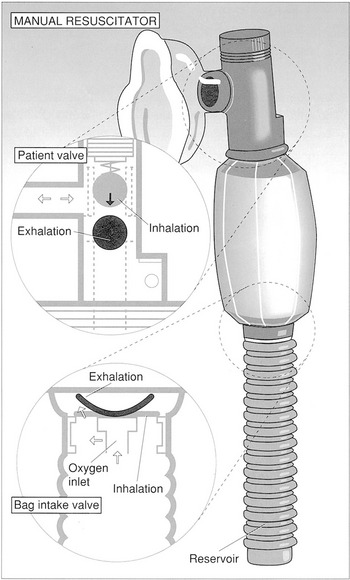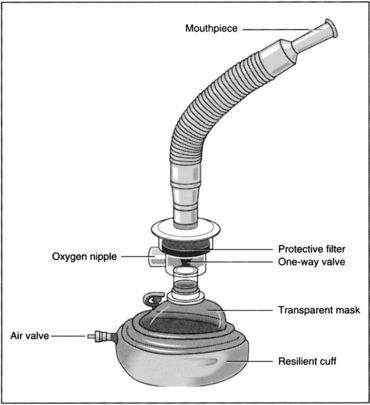CHAPTER 6 CARDIOPULMONARY RESUSCITATION TECHNIQUES
PRETEST QUESTIONS
1. You enter a patient’s room to give a treatment and observe the patient is unconscious and not breathing. After calling for help, your first action should be which of the following?
2. After 10 min of CPR, an infant’s pulse returns but no ventilatory effort is present. The respiratory therapist should do which of the following?
3. A patient has been intubated, and CPR is being performed. The patient’s ECG strip indicates asystole, and the physician is unable to start an intravenous (IV) line. The respiratory therapist should recommend which of the following immediately?
4. Which of the following drugs is used to treat ventricular fibrillation during CPR?
5. During CPR, the patient’s ECG strip indicates ventricular fibrillation. The patient has been defibrillated with 200 J using a biphasic defibrillator with no change in the ECG reading. The respiratory therapist should recommend which of the following?
6. A patient’s ECG strip indicates atrial fibrillation and cardioversion should be attempted. The defibrillator should be set at what level to return the heart to normal function?
REVIEW
I. CARDIOPULMONARY RESUSCITATION
CRT Exam Content Matrix: IB2a, IIIG4d, III I1a-d
RRT Exam Content Matrix: IB2a, IIIG4a, III I1a-c
II. ADULT, CHILD, AND INFANT CPR MODIFICATIONS
CRT Exam Content Matrix: III I1a-d
RRT Exam Content Matrix: III I1a-c
 to 2 inches with two hands stacked and the heel of one hand on the lower half of the patient’s sternum
to 2 inches with two hands stacked and the heel of one hand on the lower half of the patient’s sternumIII. CPR: SPECIAL CONSIDERATIONS
CRT Exam Content Matrix: III I1a-d
RRT Exam Content Matrix: III I1a-c
RRT Exam Content Matrix: None listed
V. PHARMACOLOGIC INTERVENTION DURING CPR
CRT Exam Content Matrix: IIID5c, IIIG4d, III I1a-d, III I3d
RRT Exam Content Matrix: IIID5c, IIIG4a, III I1a-c, III I3d
VI. DEFIBRILLATION AND CARDIOVERSION
CRT Exam Content Matrix: IIIJ7
RRT Exam Content Matrix: IIIJ8
CRT Exam Content Matrix: IA1, IB5f
RRT Exam Content Matrix: IA1, IB5e
VIII. TRANSPORTING THE CRITICALLY ILL PATIENT
CRT Exam Content Matrix: III I3a-b
RRT Exam Content Matrix: III I3a-b
![]() Exam Note
Exam Note
Questions relating to transporting patients via land or air appear on the RRT examination only.
IX. PARTICIPATING IN DISASTER MANAGEMENT
CRT Exam Content Matrix: III I3c
RRT Exam Content Matrix: III I3c
POSTCHAPTER STUDY QUESTIONS
1. List three medications that are commonly instilled directly down the ET tube.
2. What is the major indication for the administration of dopamine?
3. List two indications for lidocaine.
4. Sodium nitroprusside (Nipride) is indicated for the treatment of what condition?
5. Describe the proper airway management of a postterm neonate in whom meconium aspiration is suspected.
6. When resuscitating a neonate immediately after delivery, what is the proper ventilation rate and peak inspiratory pressure for manual ventilation?
7. List four criteria that aid in delivering the highest O2 concentration with a manual resuscitator.
8. What is the initial current delivered during defibrillation of an adult with a monophasic defibrillator? With a biphasic defibrillator?
9. What is the maximum current used to defibrillate an adult?
10. List two drugs that may be administered to improve the success of defibrillation.
11. List five arrhythmias that cardioversion is used to terminate.
12. How many joules are delivered to the patient during cardioversion?
13. List three potential consequences that could affect a patient during an air transport at high altitude.
Aehlert B. ACLS quick review study guide, ed 3. St Louis: Mosby; 2007.
American Heart Association, CPR guidelines, Dallas, 2005.
Hess DR, Respiratory care principles and practice, ed 1, Philadelphia, Saunders, 2002.
Wilkins RL, Stoller JK, Kacmarek R. Egan’s fundamentals of respiratory care, ed 9. St Louis: Mosby; 2009.






